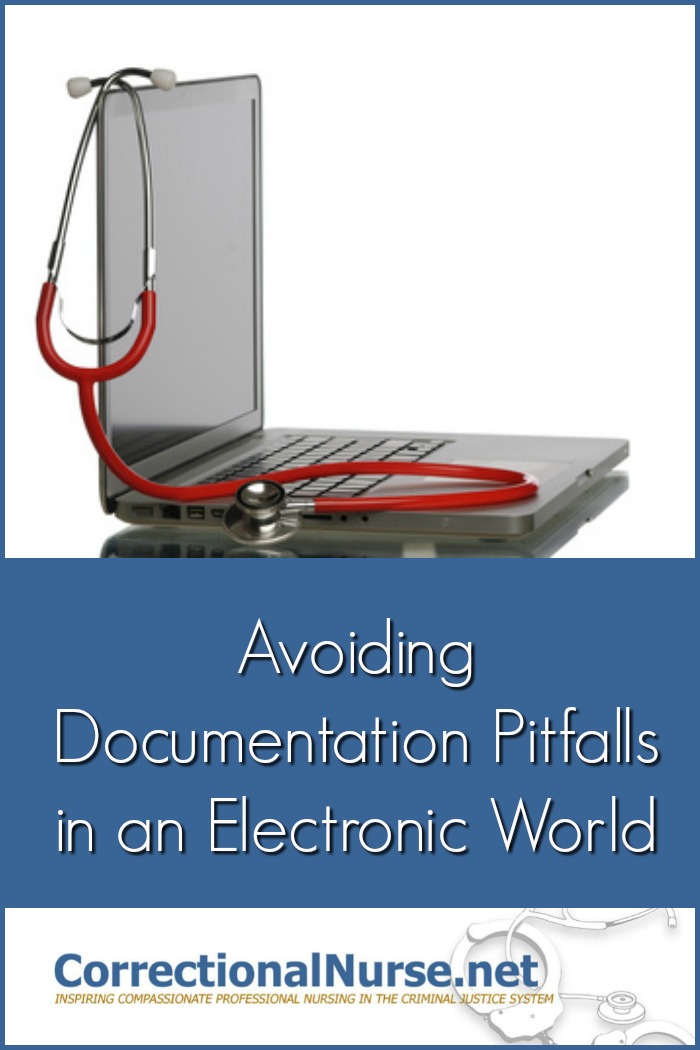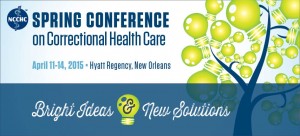Jackie Griffin-Rednour, RN, BAS, CCHP, is Clinical Nurse Educator for Correctional Health Services in Phoenix, AZ. This post is based on her session “Protecting Your Nursing License: Avoiding Documentation Pitfalls in an Electronic World” taking place at the Spring 2015 NCCHC Spring Conference on Correctional Health Care in New Orleans, April 11-14, 2015. Learn more about the conference and register HERE.
 The Electronic Health Record (EHR) in the clinical setting has been hailed as the answer to all our documentation issues. Indeed, EHRs provide many benefits, but correctional nurses can still find themselves in hot water if they don’t follow basic documentation principles…..and, if they don’t consider the risks along with the benefits of documentation technology.
The Electronic Health Record (EHR) in the clinical setting has been hailed as the answer to all our documentation issues. Indeed, EHRs provide many benefits, but correctional nurses can still find themselves in hot water if they don’t follow basic documentation principles…..and, if they don’t consider the risks along with the benefits of documentation technology.
Electronic Health Record – Thumbs Up or Thumbs Down?
There are many benefits to an electronic health record. A key one being improved patient outcomes. Improved legibility, efficiency and availability of patient health information allow clinicians to deliver timely, accurate, and relevant care.
HealthIT.gov lists key benefits of electronic health documentation
- Availability at the point of care
- Clinical alerts and reminders such as drug-drug incompatibility and patient allergies
- Improved quality of care screenings
The electronic health record also affords users with the ready availability of clinical decision support (like drug/allergy interactions or best practice guidelines), which has the potential to prevent errors and improve patient outcomes.
Good systems, though, are costly. Initial costs for purchase and maintenance of an electronic health record may seem excessive. However, when compared to the manpower hours involved in maintaining paper records, the cost difference is likely minimal. Another difficulty can be basic human nature and the reluctance to change. It requires a shift in paradigm from a paper mentality to a technological one; not to mention the need to change policies and procedures to accommodate new documentation processes.
Do EHRs Improve Nursing Documentation?
It can be difficult to say whether a move to an EHR in the correctional setting improves nursing documentation. Jackie Griffin-Rednour shares her experiences in transitioning to an electronic record within a correctional setting. “From the point of legibility, the use of an electronic health record has certainly improved the readability of the documentation. It has certainly improved efficiency and reduced our need to have staff transcribe orders or file loose paperwork.”, she stated. According to Griffin-Rednour, one of the major improvements has been the ability for managers to review and evaluate nurse’s documentation to comply with NCCHC’s standard J-C-02 Clinical Performance Enhancement. Prior to electronic records, managers had to manually retrieve, review, and in some instances, decipher, the paper documentation. The use of an electronic record facilitates ready access to patient records for review, allowing timely feedback for staff.
One Size Does Not Fit All
An EHR must be tailored to the specific needs of the clinical setting. A system created for an acute care facility, for example, will not have workflows that accommodate the special processes in correctional health care. So, a first step is to identify current clinical processes before reviewing options. Though there are many generalities within a correctional environment, each facility has processes that are unique to their particular setting and should be a strong consideration when selecting a product.
Customization is an important feature as every facility will need to alter various processes to accommodate site-specific policies and procedures. For example, setting vital sign parameters for alerts.
The best system would also integrate with an organization’s custody system and any other outside service providers, such as pharmacy or labs. This improves information integration and streamlines data-sharing.
Lastly, development of an education plan to roll out the new electronic health record is necessary for success. The plan should include an assessment of clinician readiness with evaluation of staff’s technical abilities. Pre-implementation training may be necessary to prepare staff with basic computer skills.
Avoid These EHR Documentation Pitfalls
No matter what type of nursing documentation in use, missing documentation is always a concern. Whether by paper or electronic documentation, if it doesn’t appear on the record, it is legally suspect as to whether it was actually completed. Here are some issues specific to EHR documentation.
- Cloning information and copying/pasting: The ease of copying information from one part of the record to another can lead to misinformation populating the patient’s record.
- Over-reliance of templates: Templates are a great time-saver when used correctly but templates can also add in extraneous information not applicable to every patient. Staff need to understand how to customize templates to the patient condition.
- Ignoring alerts: Flashing or ringing alerts in a documentation system can become background noise much like a touchy IV alarm. Nurses must guard against a tendency to become ‘tone-deaf’ to documentation alerts; thereby, rendering them ineffective.
Staff education and convenient information resources are ways to combat the above pitfalls. These can include a training portal specific to the electronic health record that lists all approved documentation processes as a quick reference. A specific “Test” environment can be set up that mirrors the electronic production environment.
The EHR must be integrated into staff development programs including:
- New staff training and practice time prior to orientation in clinical units
- Reinforcement classes every two to three months to allow staff to refresh skills, learn new features, and practice in the “Test” environment
- Ongoing information relevant to pertinent changes, emerging trends or problem areas provided to staff in newsletters or emails
What are your experiences with using electronic documentation in your correctional nursing practice? Share your thoughts in the comments section of this post.
This post is part of a series discussing topics addressed during sessions of the 2015 NCCHC Spring Conference on Correctional Health Care. All posts in this series can be found HERE.

Sue M Lane says
Lori,
I have changed companies,
Please Contact me as below
Look forward to hearing from you.
Sue Lane
Lorry Schoenly says
Hi, Sue: I tried to reach you at the email that you list but it bounced. Please email me at lorry@correctionalnurse.net.